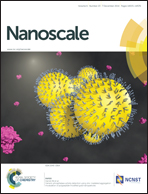A gate controlled molecular switch based on picene–F4TCNQ charge-transfer material†
Abstract
We show that the recently synthesized charge-transfer material picene–F4TCNQ can be used as a gate-voltage controlled molecular switch. The picene–F4TCNQ system is compared with the extensively characterized anthraquinone-based molecular system, which is known to exhibit large switching ratios due to quantum interference effects. In the case of picene–F4TCNQ we find switching ratios larger by one order of magnitude. Further, our calculations reveal that the picene–F4TCNQ system resembles remarkably well the I–V characteristics of a classical diode. The reverse-bias current of this molecular diode can be increased two orders of magnitude by an external gate voltage. Based on density-functional theory calculations we show that the hybrid states formed by the picene–F4TCNQ system play the key role in determining transport properties. We further conclude that the tuning of quantum transport properties through hybrid states is a general concept which opens a new route towards functional materials for molecular electronics.


 Please wait while we load your content...
Please wait while we load your content...